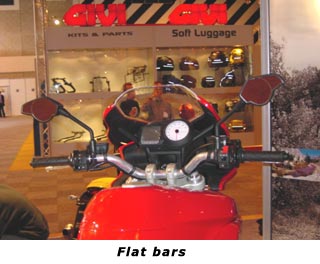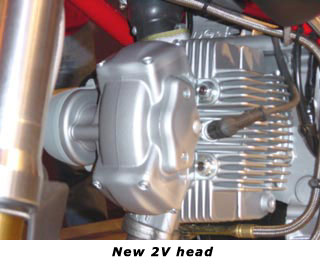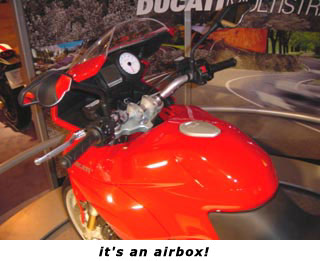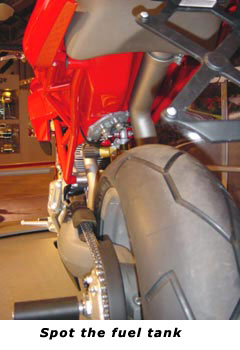|
 The NEC motorcycle show in 2001 saw the first presentation in the UK of the new Ducati family, the Multistrada. Destined for production in 2003 this
bike is a radical departure for the company. The NEC motorcycle show in 2001 saw the first presentation in the UK of the new Ducati family, the Multistrada. Destined for production in 2003 this
bike is a radical departure for the company.
High barred, aggressive and quality spec'ed, the motorised Mountain bike
comes to Ducati! Just as aging 'baby boomers' got off their cramped racing pedal cycles and grasped the more comfortable Mountain bikes to their bosom, Ducati now seems to be going
the same way with 'high spec' sports bikes that do not require you to suffer physical agony in order to enjoy the pleasure of owning and customising top line equipment - Ohlins Shocks,
Brembo brakes, Marchesini wheels and Shimano gears (oops sorry, got a bit carried away there, I meant close ratio gearboxes!!!).
This is the start of a new group or family of bikes for Ducati. Although I am sure they would like
to think this niche is unique it does seem to have quite a few similarities to the now sadly discontinued TDR Yamaha I was buzzing around on ten years ago; the only other current
occupant of this niche would appear to be Yamaha's 900 TDM. More sophisticated and street ready than merely an oversize SuperMotard the Multistrada is designed to allow its owner to
enjoy the pleasure of a sporting and charismatic Ducati in a package far more suitable to the real world in which we live than the top line narrow focus sport bikes for which the firm is currently most famous.
The style is very Ducati but with new practicality and comfort; it looks perfectly suited to the real
back roads where booming torque and easy manageability easily outstrip machines built for 150 mph cornering, (think of the roads up Mount Tamalpais outside San Francisco, the twisties in the
mountains of central Italy, think also of the D roads of France and the little lanes of England); a seating position that would do equal justice to a 25 year old or  someone who is beginning to notice that walking slowly down stairs causes those funny twinges in the knees…..you know! Think also of a
machine with substantial street cred that you can take to work in the city on a nice day or away for that long weekend without the need for racing leathers. someone who is beginning to notice that walking slowly down stairs causes those funny twinges in the knees…..you know! Think also of a
machine with substantial street cred that you can take to work in the city on a nice day or away for that long weekend without the need for racing leathers.
Standing next to it, it is a lot smaller than the pictures make it seem, the wheelbase is very short and the
seat height as low as you could hope for, Pierre Terblanches brilliant ability to narrow the front of the saddle is also very obvious. There
are styling cues from the Hailwood Rep and the Gran Canyon as well as lots of little touches like the shape of the mirrors and the radical rear light unit.
 The engine
. The engine
.
The motor is a true development of the Pantah derived 900, but now with a shorter stroke and bigger bore, they
are not saying how big. Like the Testatretta the heads are tidier and simpler with no roller bearings; this is quieter and requires less parts. The twin spark idea is one that is fairly rare,
Alfa Romeo cars have it and it has been a tuning mod on old 2 valve engines for years. It can have unfortunate side effects if not done correctly with two pressure wave fronts active in the
combustion chamber at the same time leading to detonation; I am sure here it is part of a very sophisticated attempt to ensure a clean and efficient burn. The new motor bodes well for the whole
2 valve range though, we are almost certainly seeing the birth of a new engine intended ultimately for the 900SS and monster here as well. The next few years are going to be interesting.
The packaging wars.
The bike itself is a triumph of new design thinking, finding room in an increasingly tight and small
package for all the things that let the machine operate to its maximum potential, all the time staying within the increasingly tight guide lines on noise and atmospheric emissions.
 A brief aside here; Airboxes and fuel
tanks compete for the same space: big twins need big airboxes to allow the pulsing 'Helmholz resonator' effect from a properly designed box to maximise the power and torque available (this is worth a separate
tech article all of its own, which will follow in due course). There are many examples of the problem and to date only three bikes with what I would regard as good solutions.
Problem bikes include the Monster and ST bikes where opening the top of the airboxes (effectively increasing their volume to infinity) really fills out the dips in the torque curve; another
major problem bike is the VTR1000 Honda, they built a good size airbox and torque curve but restricted you to a 90 mile fuel range; with a five mile reserve (do not ask how I found that
out, twice!). I am not going to even talk about Harley Sportsters. A brief aside here; Airboxes and fuel
tanks compete for the same space: big twins need big airboxes to allow the pulsing 'Helmholz resonator' effect from a properly designed box to maximise the power and torque available (this is worth a separate
tech article all of its own, which will follow in due course). There are many examples of the problem and to date only three bikes with what I would regard as good solutions.
Problem bikes include the Monster and ST bikes where opening the top of the airboxes (effectively increasing their volume to infinity) really fills out the dips in the torque curve; another
major problem bike is the VTR1000 Honda, they built a good size airbox and torque curve but restricted you to a 90 mile fuel range; with a five mile reserve (do not ask how I found that
out, twice!). I am not going to even talk about Harley Sportsters.
The original 'Lunch box on the side of the bike' Buell was a good effort as was the big tank 996
Corsa of 1998. Both of these bikes solved one problem, getting a big properly designed airbox on the bike, both found it caused other problems, the riders hated the way that the fuel tank
restricted their mobility on that years Corsa and the Buell just looked pig ugly.
 Resolutions to this trade off are coming thick and
fast now; well at least amongst the design leaders. Ducati moved first with the 748R airbox, real big and deep with hardly any downsides, the same
design is on the 996RS racebikes. Buell (and Harley for that matter) have shocked a lot of people this year with two brilliant new concepts, well executed ones at that. Mind you it is rather overdue…. The
main one for these pages is the Buell Firebolt, the oil is in the front of the swingarm, the fuel in the frame spars, both clearing space so they can get a really BIG airbox in above the engine. Resolutions to this trade off are coming thick and
fast now; well at least amongst the design leaders. Ducati moved first with the 748R airbox, real big and deep with hardly any downsides, the same
design is on the 996RS racebikes. Buell (and Harley for that matter) have shocked a lot of people this year with two brilliant new concepts, well executed ones at that. Mind you it is rather overdue…. The
main one for these pages is the Buell Firebolt, the oil is in the front of the swingarm, the fuel in the frame spars, both clearing space so they can get a really BIG airbox in above the engine.
The Multistrada, almost unnoticed by the press as far as I can see is up there with a seat tank. A
careful look above the rear wheel shows the 'first for Ducati' 2 into 1 into 2 pipes snuggling into a space made by the fuel tank, the fuel injection pipe ware is there for all to see. This means the Ducati
have done the same as Buell, the thing between your knees isn't a tank, it may have a filler cap in it but it can most beneficially be an Airbox of the right capacity, and the right resonance, to give that 1000
cc two valve engine a torque curve to die for. You might also have the fuel held lower and in a less disadvantageous position for the C of G (I would like to think there is plenty of baffling to keep it all
in one place when you hit the brakes though), but that is a happy side effect.
On the basis of the nicely tuned 2 valve engines I have seen I reckon we are talking a nearly 100
bhp engine with monster (sic) torque here; just the thing for embarrassing all those sporty café racers in the tight stuff; and your knees and wrists won't hurt!
I can't wait for a first ride.
Neil Spalding 2001
|